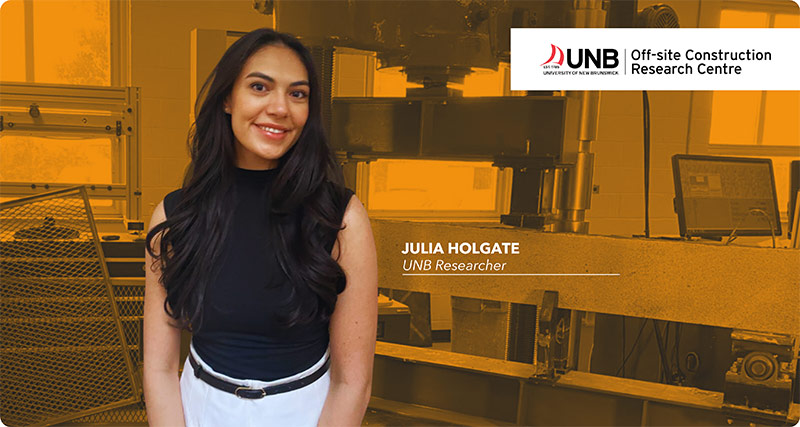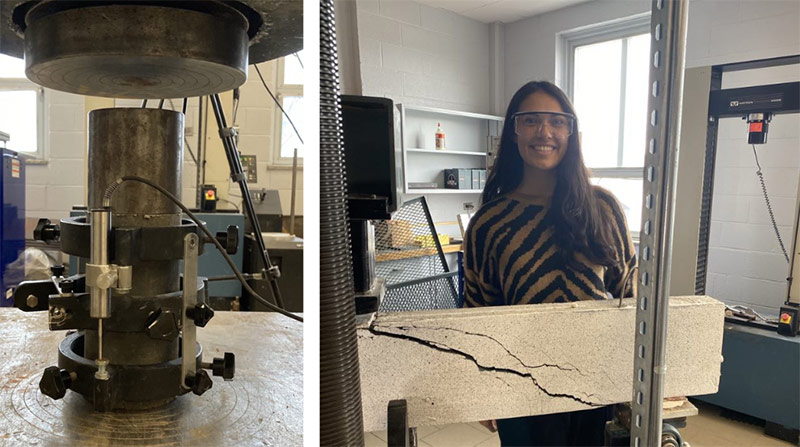UNB OCRC innovator: Advancing arctic housing through off-site construction with Julia
Author: OCRC
Posted on Oct 23, 2024
Category: Student spotlight

Meet Julia Holgate, a UNB graduate student developing ultra-high-performance concrete for Arctic precast applications. Drawn by UNB’s strong engineering program, Julia became passionate about off-site construction, recognizing its potential to solve challenges in cold climates and accelerating affordable housing projects. Despite hurdles like transportation and standardization, she is excited to apply their research to real-world construction challenges and explore opportunities in both industry and academia.
What brought you to UNB?
The good engineering program and beautiful campus. UNB was recommended by a family friend. I grew up in Toronto and thought a change of scenery would be nice.
What was your research topic?
It was on the development of an Ultra-high-performance concrete material to be used for precast residential applications in the Arctic. The intentions behind the development of the product were to reduce the size and weight of precast components by increasing the strength of the concrete material itself. This would in turn reduce transportation costs, accelerating on-site construction, reducing on-site skilled labour requirements, and producing durable and low maintenance housing.

What interested you in doing research in off-site construction?
What really interested me in off-site construction was how new innovative designs and methods for building were being used to solve a lot of the current issues that the traditional construction industry faces.
For example, my project addresses the construction issues faced in cold climates. On-site construction is often limited by environmental conditions such as temperature, precipitation and daylight. Since the components are prefabricated in a controlled environment, this alleviates the labour requirements on-site and allows for the construction of components to continue throughout the year.
In other parts of the world the benefits of off-site construction have been used to accelerate construction. During covid, a hospital with the capacity for 1000 patients was built in Wuhan, China in just 10 days. In England, many off-site construction facilities have shifted towards using automated processes and robotics to address the labour shortages in the construction industry. In Belgium, many facilities have taken advantage of off-site construction processes to better manage and recycle their waste.
In your opinion, what are the biggest opportunities coming up in off-site construction? What are the barriers?
Off-site construction transforms the way that construction is perceived. It offers practical solutions to the challenges encountered in traditional construction. With off-site construction, a project that would have taken years to complete, can now be completed within weeks. In Canada, the biggest opportunities coming up in off-site construction will be in addressing the affordable housing issue. Taking advantage of the benefits of off-site construction will permit for an increase in the speed of construction without compromising on the quality of buildings. Shifting from on-site to off-site also introduces an element of stability for workers in the construction industry by allowing them to work in a safer, controlled environment, that is less dependent on external conditions and requires less skilled labour.
Despite the many benefits, these new practices come with their own set of issues that will need to be tackled. Transporting elements can become cumbersome based on their various sizes and shapes, and the floorspace of factories can quickly become overwhelmed by the need for storage. Although some elements may be stored outdoors, they risk damage due to thermal expansion. Additionally, there are concerns surrounding the adoption of new technologies. Training will be required for manufacturers looking to use the more advanced technologies and methods of off-site construction. The last barrier would likely be the standardization of components. To maximize efficiency, products need to be standardized and catalogued; however, I think that this reduces the amount of creative freedom that designers will have.
Tell us a bit about your graduate student experience. What was it like starting out? What were some of the highlights?
Starting out was a little intimidating because at the start of my project, I was not exactly sure where my research was going to take me, but once I got into the groove of things, the research became more exciting as I learned more about my topic. The biggest highlights for me were completing my work in the lab because that is where I really got to see my project come to life.
What advice would you give new graduate students?
Take advantage of the resources that you have at the school (i.e. equipment, tools, software, literature). It is such a privilege to have easy access to all of the new scientific papers surrounding your topic, either through the library or through the online portal. At the start it can be difficult, but continuing to read as much as you can on your topic should help get you started. It also really helps to talk to or follow the work of other graduate students to learn about their experiences and some of the methods that they use to manage their work.
What are your career aspirations?
At this point in time, I am not entirely sure which specific direction I would like to go. It is important to me that the work that I do is relevant to current issues, which is why I enjoy doing research in this field; however, I would like to try working in the industry.
What would you tell a high school student who is interested in a career in construction?
Since the construction industry is clearly shifting, I would encourage them to find ways to try to keep up with current events and major changes. I would also recommend that they attend some of the tours or presentations on the current work and research being done, so that they can get an idea of what sector of the construction industry that they would like to work in.
How did your study experience in OCRC help you prepare for a future career in construction?
Working in the OCRC has helped me for my future career in construction the most by providing me with the experience of directly working with the industry. Through conversations with industry partners, touring facilities and working with new technologies, I have gained insight on the real-world mechanics of the industry while also developing the skills to better evaluate and solve problems at both a high and low level.